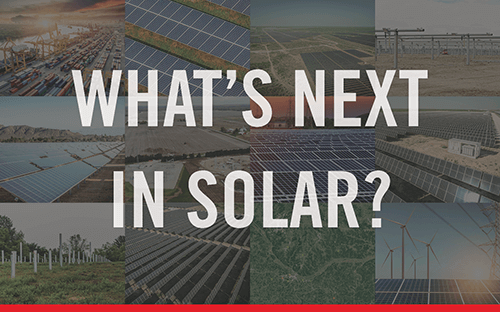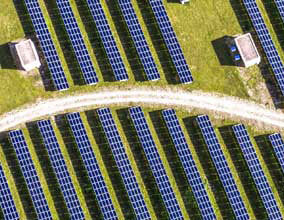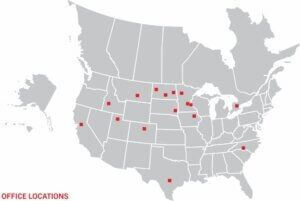What’s Next in Solar Part 1

March 11, 2022
This is the first in a series of blogposts about how Ulteig is serving the solar power industry. In today’s fast-paced clean energy world, relying on a partner that has gained the trust of renewable developers, contractors, owners and utilities is critical to success. In upcoming blogposts, watch for stories about how Ulteig is making a difference in solar power and clean energy.
Part 1: Variables Driving Growth of Solar in North America
Ulteig Solar experts discuss trends and changes shaping the future of solar power in North America
- War in Ukraine.
- Disruption to the world’s fossil fuel energy markets.
- A narrowing window to address climate change.
- Dropping solar costs.
- Increasing solar PV technology.
- Growing acceptance of EVs.
The solar power market is anything but static. Within just the past few years, the growth of solar power has accelerated, with the U.S. Energy Department’s Energy Information Administration (EIA) forecasting that solar generation will account for 14% of power generation by 2035.
However, those forecasts may be low in the context of world events. As events unfold with the war in Ukraine, calls are growing both in Europe and in North America for more energy self-sufficiency, which may lead to a dramatic acceleration in solar and wind energy projects. While the short-term impact of the war favors fossil fuels, according to Energy Wire (What the Russia crisis means for the U.S. electricity mix, March 1, 2022), “The long-term effects, meanwhile, could touch on everything from nuclear power to renewable energy, as industry leaders expect wind and solar to remain more insulated from price shocks and sanctions targeting Russia than fossil fuels.”
In light of all of these recent developments, the members of the Ulteig Solar team gathered to discuss where they think the industry is headed. Even before the conflict in Ukraine, the team foresaw a strong pattern of growth fueled by the desire of the utility industry to lower its carbon footprint and the extension of the Investment Tax Credit.
Within the past several years, Ulteig has been at the forefront of solar’s growth in the U.S. Last year alone, Ulteig worked on over 65 solar projects, ranging in size from 15 MWAC to over 575 MWAC. Over the past 10 years, the firm has designed solar projects producing more than 20 GW of power.
While energy self-sufficiency and addressing climate change will continue to remain strong drivers of growth for solar, there are a number of other variables that are supporting its growth.
Cost of Solar Drops Below Fossil Fuels – With the costs dropping in recent years, solar PV quickly became the most cost-effective form of power generation. Dramatic drops in the cost for solar panels, solar inverters, mounting and tracking systems are giving traditional fossil fuels a run for their money. According to a World Economic Forum report issued in November 2021, the cost of solar has dropped 80% since 2010, from $378 per megawatt hour of electricity to just $68 (for the year 2019). In comparison, the cost for coal is $109 per MW hour of electricity.
 “From a market standpoint,” said Chad Crabtree, PE, Market Director-Renewables, “solar has become the cheapest form of technology for building new generation. The cost reduction curve to build these plants has been steeper in solar than wind.”
“From a market standpoint,” said Chad Crabtree, PE, Market Director-Renewables, “solar has become the cheapest form of technology for building new generation. The cost reduction curve to build these plants has been steeper in solar than wind.”
While the Ulteig Solar team forecasts continued optimization and delivery of solar power, other factors may hamper that trend line, including geopolitical pressures, stalled federal energy policy, a shortage of construction workers, and rising parts and materials costs due to tariffs and supply chain issues.
Solar is Migrating North (and East, too) – When many people think about solar, they often think that it must be placed in locations such as California or the Southwest because those areas have more sunny days. And while solar projects are expected to grow in Texas and California in the near term, the Ulteig solar team is seeing the installation of solar in some not so warm and not so sunny places. Within the past year, the Ulteig team has worked on solar projects in places such as Tennessee, Ohio, Kentucky and even “cold, snowy” places such as Minnesota.
 “The reason we’re seeing solar migrate is because the cost of solar itself is falling. So, in places where it didn’t make sense, let’s say 10 years ago, now it makes sense because the actual cost of the technology has dropped. It doesn’t have to produce as much energy to pay for itself, essentially,” said Devin Radovich, Market Development Manager-Renewables.
“The reason we’re seeing solar migrate is because the cost of solar itself is falling. So, in places where it didn’t make sense, let’s say 10 years ago, now it makes sense because the actual cost of the technology has dropped. It doesn’t have to produce as much energy to pay for itself, essentially,” said Devin Radovich, Market Development Manager-Renewables.
 “We’re seeing solar projects developed and built in places traditionally known for their cold weather and snow,” said Chris Smaaladen, PE, Technical Manager-Civil. “I live in Fargo where we have a lot of snow and thought for the longest time that solar projects were only built in warm sunny locations but as the technology has evolved, that doesn’t really matter anymore. What most people don’t know is that the sun will penetrate any snow that does build up on the solar modules and then as the trackers rotate the snow will either melt or slide right off. So now we are seeing solar in places like Colorado, the Dakotas and a lot of other northern areas.”
“We’re seeing solar projects developed and built in places traditionally known for their cold weather and snow,” said Chris Smaaladen, PE, Technical Manager-Civil. “I live in Fargo where we have a lot of snow and thought for the longest time that solar projects were only built in warm sunny locations but as the technology has evolved, that doesn’t really matter anymore. What most people don’t know is that the sun will penetrate any snow that does build up on the solar modules and then as the trackers rotate the snow will either melt or slide right off. So now we are seeing solar in places like Colorado, the Dakotas and a lot of other northern areas.”
Access to Land/Locations – As more solar and wind projects are built, the ideal locations – those with the easiest and least costly interconnects – are being gobbled up. While there are more locations available for solar in the years to come, access to lower cost locations will become less and less.
“It’s our job to continue finding ways to bring cost-effective solutions,” said Crabtree, “As solar expands to other parts of the country, we may need to deal with other variables such as undulating terrain, subsurface challenges, and lengthy and cost-prohibitive grid interconnection.”
Battery Storage is Taking Off – According to a report by Energy Storage News (Feb. 18, 2022), “utility-scale BESS capacity quadrupled to 10.8 GWh over the course of the [past] year. It now accounts for 2% of the country’s total clean power capacity of 200GW, about double 2020’s proportion.” Based on recent projects, the Ulteig solar team foresees more solar projects that incorporate Battery Energy Storage Systems (BESS).
 “A significant portion of our current renewable projects have some component of battery storage. These projects are a mix of AC and DC-coupled storage tied to solar and wind. We’re anticipating this trend to continue and scale upwards as project sizes increase.” said Greg Brunke, Technical Manager-Automation, Integration and System Protection (AISP).
“A significant portion of our current renewable projects have some component of battery storage. These projects are a mix of AC and DC-coupled storage tied to solar and wind. We’re anticipating this trend to continue and scale upwards as project sizes increase.” said Greg Brunke, Technical Manager-Automation, Integration and System Protection (AISP).
 “I would say roughly 50% to 75% of all new projects now include a storage component,” added Jake Hermanson, Technical Manager-Collections. “Sometimes the storage component is not built into the original project but is often added later.”
“I would say roughly 50% to 75% of all new projects now include a storage component,” added Jake Hermanson, Technical Manager-Collections. “Sometimes the storage component is not built into the original project but is often added later.”
Supply chain worries – One of the greatest concerns that the Ulteig solar team is hearing among its clients is worries related to obtaining components to complete their projects in a timely manner. According to a Q4/2021 report by Solar Market Insight Report, “supply chain constraints and logistics challenges, including months of disrupted shipments due to the recently dismissed AD/CVD petition, are expected to lower the 2022 outlook for U.S. solar by 25% or 7.4 GWdc.” In some cases, solar project clients have had to change their project plans because they were not able to obtain components from their preferred vendors.
 “I think some of our clients are not getting the components they would prefer,” said Nick Knezevich, Market Development Manager-Renewables “and at times they’re dealing with second or third-tier vendors, when necessary.”
“I think some of our clients are not getting the components they would prefer,” said Nick Knezevich, Market Development Manager-Renewables “and at times they’re dealing with second or third-tier vendors, when necessary.”
Engineering for resilience – The number and intensity of super storms are increasing due to climate change and global warming, and wildfires throughout the Western U.S. and Canada are becoming more commonplace. Ulteig solar engineers are aware of these changes and are engineering solutions to ensure that solar projects are more resilient to meet a changing climate.
 “The solar modules today are super, super resilient,” said Andrew Melvin, PE, Technical Manager-Solar PV, “From my previous experience in rooftop solar in Colorado, I’ve seen the modules handle giant hailstones and remain undamaged. So really what we as designers need to do is understand our clients’ appetite for risk. Do they want us to design a solar project for a 500-year storm? Some clients are saying, ‘You know what, I don’t want to spend the money. I’m willing to take the risk and design for lower conditions.’ We also design our projects based on the most conservative wind ratings,” Melvin added. “If an owner does experience damage after that 1 in 1,000-year event, usually it’s a small part of the system and the system continues to operate. It’s really unlikely that you’ll lose the whole system in a single go.”
“The solar modules today are super, super resilient,” said Andrew Melvin, PE, Technical Manager-Solar PV, “From my previous experience in rooftop solar in Colorado, I’ve seen the modules handle giant hailstones and remain undamaged. So really what we as designers need to do is understand our clients’ appetite for risk. Do they want us to design a solar project for a 500-year storm? Some clients are saying, ‘You know what, I don’t want to spend the money. I’m willing to take the risk and design for lower conditions.’ We also design our projects based on the most conservative wind ratings,” Melvin added. “If an owner does experience damage after that 1 in 1,000-year event, usually it’s a small part of the system and the system continues to operate. It’s really unlikely that you’ll lose the whole system in a single go.”
At Ulteig, our grid experts are always looking ahead at what’s next to ensure that today’s demands and future challenges are accounted for in each and every project for sustainable infrastructure that can stand the test of time.
Learn More about Ulteig’s Solar Capabilities
Ulteig supports the development, performance and design of medium to large, grid-connected, solar electric projects including the utility-scale and commercial & industrial distributed generation markets. In addition to medium voltage collection systems, substation, SCADA, transmission, civil and GIS services, we also specialize in performance evaluation and plant design including DC collections and pile design. To learn more about Ulteig’s Solar expertise, click here.
WHAT MAKES ULTEIG DIFFERENT?
From global energy producers to locally funded cities and private developers to government agencies, the clients we serve encompass a broad range of relationships and projects. Find out why Ulteig is a leader in the engineering industry.
Contact Us


